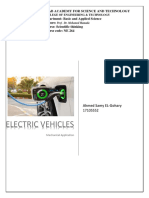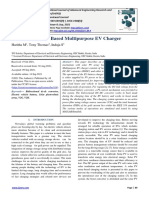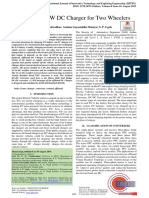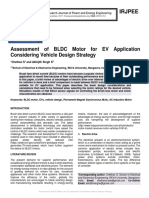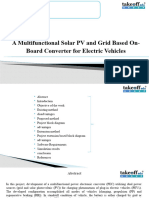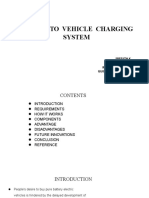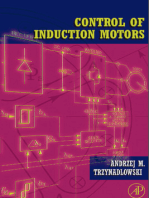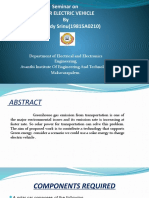Professional Documents
Culture Documents
Design and Development of Controller For Electric Vehicle
Design and Development of Controller For Electric Vehicle
Original Title
Copyright
Available Formats
Share this document
Did you find this document useful?
Is this content inappropriate?
Report this DocumentCopyright:
Available Formats
Design and Development of Controller For Electric Vehicle
Design and Development of Controller For Electric Vehicle
Copyright:
Available Formats
Volume 9, Issue 4, April – 2024 International Journal of Innovative Science and Research Technology
ISSN No:-2456-2165 https://doi.org/10.38124/ijisrt/IJISRT24APR174
Design and Development of
Controller for Electric Vehicle
Yash U. Yadav1; Nikhil B. Kolhatkar2; Abhishek D. Dakawale3; T. V. Deokar4
BE Electrical Student1,2,3; Associate Professor4
Electrical Department, SBPCOE Indapur
Abstract:- In this paper, we designing and developing Electrical Vehicle
controller and converter for the electric vehicles. In the Electric vehicles are classified in to four main types:
electric vehicle battery is used as the energy source, by
using of this battery operating electric motor. If we Electric vehicles are classified based on the type of
connect this battery direct to motor without any control power source they use and the degree of electrification they
device then it causes some unwanted problems in EV’s. have. There are four main types of electric vehicles:
Because of the output voltage of battery is not suitable to
operating Electric vehicles. Which means without any Battery electric vehicles (BEVs): These are fully powered
control mechanism the output voltage cannot be by electricity and have no internal combustion engine or
controlled and it will give divergence in output voltage in fuel tank. They rely on a large battery pack that can be
terms of error signal. Its result battery output power will charged by plugging into an external source of electricity.
reduce and therefore the performance of electric vehicle Plug-in hybrid electric vehicles (PHEVs): These use both
is go down in terms of power torque to drive vehicle. So an internal combustion engine and a battery-powered
in electric vehicle use of control mechanism is mandatory electric motor. The battery can be charged by plugging
to control the output voltage of battery and that can into an external source of electricity or by the engine.
achieve proper power and torque by a proper feedback PHEVs can switch between electric and hybrid modes
control system. But price of the EV’s are to much high depending on the driving conditions.
higher the electric vehicle because of battery, motor and Hybrid electric vehicles (HEVs): These also use both an
EV Controller. internal combustion engine and a battery-powered electric
motor, but the battery cannot be charged externally. The
Keywords:- Sensors, Motor, Microcontroller. engine is used to drive the vehicle and to charge the
battery when it is low HEVs are more efficient than
I. INTRODUCTION conventional vehicles, but less efficient than PHEVs or
BEVs.
Transportation is very important in for the development Fuel cell electric vehicles (FCEVs): These use a fuel cell
of a country. it enables the movement of people, goods and to generate electricity from hydrogen and oxygen. The
services. Which helps to growth of various sectors of only emission from FCEVs is water vapor. FCEVs have a
economy. Road transportation is primary mode of high driving range and can be refueled quickly, but they
transportation it consumes 88% sector of total transportation. are expensive and require a hydrogen infrastructure.
To that transportation IC engine vehicles are used. Controller
is used in EV’s to control various actions of motor. A II. LITERATURE SURVEY
controller is a device that controls the speed, torque,
direction, and power of an electric motor that drives an EV. A. Paper 1: “A Study on Recent DC-DC Converters”
It also enables the regenerative braking, which recovers some Sidharth Sabyasachi, Mousumi Biswal's.
of the energy lost during braking. converter is also important This paper presents a study on recent developments in
part of EV it decrees or increase the voltage level according dc-dc converters. All the converters are derived based on the
to required voltage rating. In EV different component are two basic converters such as buck converter and boost
used which operate at low voltage rating and battery output converter. The aims of developing the converters are high
voltage is high it will possible to damage components. efficiency and high gain with fast response. Research work
therefore converter is used in EV’s. But the cost of EV’s is has been grown dramatically to provide the service to the
higher than IC engine vehicles because of cost of battery, mankind.
motor and controller. In this paper we are representing the
design and the development of EV controller and controller B. Paper 2: “Methods of Fast Analysis of DC–DC”-
at cheaper cost and low weight. Górecki, P.; Górecki, K.
The paper discusses the methods of fast analysis of DC–
DC converters dedicated to computer programs. Literature
methods of such an analysis are presented, which deter-
mination of the characteristics of the considered converters in
the steady state and in the transient states.
IJISRT24APR174 www.ijisrt.com 119
Volume 9, Issue 4, April – 2024 International Journal of Innovative Science and Research Technology
ISSN No:-2456-2165 https://doi.org/10.38124/ijisrt/IJISRT24APR174
C. Paper 3: “DC-DC Converters for Electric Vehicles”- adjust the amount of electricity in the windings to change the
Joeri Van Mierlo ,Monzer Al Sakka,Hamid Gualous. speed and torque of the motor.
DC-DC converters can be used to interface the elements
in the electric power train by boosting or chopping the voltage The BLDC motor controller has some advantages over
levels Thus, in this chapter, a comparative study on three a brushed DC motor controller. It is more efficient, reliable,
DC/DC converters topologies (Conventional step-up dc-dc and durable because it does not have any mechanical parts
converter, interleaved 4-channels step-up dc-dc converter that wear out sparks. It also produce less noise and heat.
with independent inductors and Full-Bridge stepup dc-dc
converter) is carried out. The modeling and the control of III. PROPOSED SYSTEM
each topology are presented.
A. Problem Statement:
D. Paper 4: “Controller Design for Electric Motor Derived
Vehicle”- Degu Mena ,Nitin Kumar Saxena *. Control of Motor Speed:
In this paper, proportional and integral based controller The speed of an electric vehicle (EV) is controlled by
is designed for controlling the output voltage of battery. A PI the vehicle’s controller, which operates between the batteries
based controller is designed and implemented for this electric and the motor. The controller simply regulate DC current
motor derived vehicle in the present paper. Paper flow for DC motors. The accelerator pedal sends a signal to
demonstrates how the results improve in presence of the controller which adjusts the vehicle’s speed by changing
controller circuit for this electric motor derived vehicle. the frequency of the motor. Modern controllers adjust speed
and acceleration by an electronic process called pulse width
Motor Controller modulation.
In most of EV’s BLDC motor is used a BLDC motor
controller is a device that controls the speed and direction of This creates rotating magnetic fields that are always just
a BLDC motor. A BLDC motor is a type of electric motor ahead or just behind the poles of the motor, depending on the
that does not have any brushes or commutators to transfer direction of motion. The controller also needs to synchronize
electricity to the spinning part. Instead, it uses magnets and the timing of the electrical currents with the position of the
coils to create motion. motor, which can be measured by sensors or estimated by
algorithms.
The BLDC motor controller switches the electricity on
and off in the windings in a specific sequence. This sequence Control of Battery Voltage
makes the magnetic field of the stator change its direction and The battery voltage in an electric vehicle (EV) is
strength. The changing magnetic field attracts and repels the controlled by a battery management system (BMS), which is
magnets on the rotor, making it spin. The controller can also a device that monitors and regulates the state of the battery
pack.
B. Block Diagram:
Fig 2: Block Diagram of Controller
IJISRT24APR174 www.ijisrt.com 120
Volume 9, Issue 4, April – 2024 International Journal of Innovative Science and Research Technology
ISSN No:-2456-2165 https://doi.org/10.38124/ijisrt/IJISRT24APR174
C. Hardware Requirement: Implementation and Hardware Integration:
Implement the control algorithms and converter designs
Microprocessors using microcontrollers, digital signal processors (DSPs), or
CAN FPGA-based platforms. Develop hardware interfaces for
Motor speed sensor sensors, actuators, and communication buses to enable real-
Battrey voltage sensor time control and monitoring. Integrate the control and
Throttle position sensor converter hardware into the electric vehicle's powertrain
Breaking Sensor system.
DC to DC Converter
Testing and Validation:
D. Fundamental Steps for System Conduct laboratory tests to verify the functionality,
stability, and performance of the controller and converter
under various operating conditions. Perform hardware-in-the-
System Requirements Analysis:
loop (HIL) simulations to validate the real-time behavior of
Define the electrical specifications of the electric
the system. Ensure compliance with safety standards and
vehicle system, including voltage levels, power ratings,
regulations for electric vehicle components.
efficiency targets, etc.
Deployment and Maintenance:
Identify the control and conversion requirements such
Deploy the controller and converter systems in electric
as motor control, battery charging, power factor correction,
vehicles for field testing and real-world operation. Monitor
etc.
system performance and reliability through diagnostics and
System Modeling and Simulation: data logging. Provide firmware updates and maintenance as
needed to address issues and incorporate improvements.
Develop mathematical models for individual
components like motors, batteries, power electronics, etc.,
using circuit theory and electromechanical principles. IV. RESULT
Simulate the models using software tools like
Input Location
MATLAB/Simulink, PLECS, or LTspice to analyze the
behavior of the system under different operating conditions.
Control Algorithm Design :
Design control algorithms for motor drives, battery
management systems, and power converters. Choose
appropriate control techniques such as PI control, predictive
control, or sliding mode control based on system
requirements and performance criteria. Implement algorithms
for tasks like torque control, speed regulation, current
limiting, etc.
Converter Topology Selection and Design:
Select suitable power converter topologies such as
voltage source inverters (VSI), current source inverters (CSI),
or buck-boost converters based on the application
requirements. Design the converter circuits considering Fig 3: Input Page
factors like efficiency, voltage/current ratings, switching
frequency, and component stresses. Optimize the design for
features like soft switching, high-frequency operation, and
compactness.
Gate Drive and Protection Circuit Design:
Design gate drive circuits to properly control the
switching of power semiconductor devices (e.g., MOSFETs,
IGBTs) in the converters. Implement protection features like
overcurrent protection, overvoltage protection, and thermal
protection to safeguard the converter and connected
components.
Fig 4: Output Page
IJISRT24APR174 www.ijisrt.com 121
Volume 9, Issue 4, April – 2024 International Journal of Innovative Science and Research Technology
ISSN No:-2456-2165 https://doi.org/10.38124/ijisrt/IJISRT24APR174
V. RESULT DISCUSSION VI. CONCLUSION
Protection Mechanisms. Discuss how the Performance In conclusion, the designing and development of EV
Evaluation: controller and converter for electric vehicles is a challenging
Assess the performance of the controller and converter task that require the information about various component.
in terms of motor drive efficiency, battery charging The EV controller is responsible for controlling the speed,
efficiency, and overall system responsiveness. Discuss how torque, direction, and power of the electric motor. It also
well the control algorithms achieve desired objectives such as support various modes of operations. The electric vehicle
torque control, speed regulation, and battery management. controller is a vital component for electric vehicles, as it
Present experimental data or simulation results to illustrate regulates the speed and torque of the motor according to the
the system's dynamic response under different operating driver’s demand and the vehicle’s operating conditions.
conditions (e.g., acceleration, deceleration, steady-state
driving). REFERENCES
Efficiency Analysis: [1]. Sidharth Sabyasachi, Mousumi- Biswal's described in
Analyze the efficiency of power conversion processes “A Study on Recent DC-DC Converters” International
within the system, including losses in the converter Journal of Engineering Research and Applications
components (e.g., switching losses, conduction losses). (IJERA) ISSN: 2248-9622 www.ijera.com Vol. 2,
Compare the efficiency of different converter topologies and Issue 6, November December 2012, pp.657- 663.
control strategies to identify areas for optimization. Discuss [2]. Górecki, P.; Górecki, K. described in "Methods of Fast
the impact of efficiency improvements on the electric Analysis of DC–DC" Converters—A Review.
vehicle's overall energy consumption and driving range. Electronics 2021, 10,2920..
[3]. Joeri Van Mierlo ,Monzer Al Sakka,Hamid Gualous
Stability and Robustness: described in “DC-DC Converters for Electric
Evaluate the stability and robustness of the control Vehicles” September 2011.
algorithms under various disturbances and uncertainties. [4]. Degu Mena ,Nitin Kumar Saxena described in
Discuss the effectiveness of control strategies in maintaining “Controller Design for Electric Motor Derived
system stability during transient events such as sudden load Vehicle ” Indonesian Journal of Electrical
changes or voltage fluctuations. Present results from Engineering and Informatics (IJEEI) Vol. 6, No. 2,
sensitivity analysis to assess the system's tolerance to June 2018, pp. 125~131 ISSN: 2089-3272, DOI:
parameter variations and external disturbances. Address the 10.11591/ijeei.v6i2.282 08 November 2021.
safety features implemented in the controller and converter
design, such as fault detection, isolation, and system complies
with relevant safety standards and regulations for electric
vehicle components. Present reliability assessments,
including mean time between failures (MTBF) calculations
or failure mode and effects analysis (FMEA), to demonstrate
the system's reliability in real-world applications.
Comparison with Requirements:
Compare the achieved results with the initial design
requirements and specifications. Discuss any deviations from
the original requirements and the corresponding implications
on system performance and functionality. Highlight areas
where the system exceeds or falls short of the specified
targets and provide recommendations for future
improvements. Future Directions and Improvements Identify
potential areas for further optimization and enhancement in
the controller and converter design.
Discuss future research directions, such as exploring
advanced control algorithms, optimizing power converter
topologies, or integrating additional functionalities (e.g.,
vehicle-to-grid capabilities). Propose strategies for
addressing emerging challenges in electric vehicle
technology, such as increasing power density, improving
energy efficiency, and enhancing system integration.
IJISRT24APR174 www.ijisrt.com 122
You might also like
- Electric Motor Control: DC, AC, and BLDC MotorsFrom EverandElectric Motor Control: DC, AC, and BLDC MotorsRating: 4.5 out of 5 stars4.5/5 (19)
- Us CB 2023 Global Automotive Consumer StudyDocument22 pagesUs CB 2023 Global Automotive Consumer StudyShehjar KaulNo ratings yet
- DC Fast Charging VehcileDocument25 pagesDC Fast Charging VehcileE-dot Tech100% (1)
- A Survey and Comparison of Characteristics of Motor Drives Used in Electric VehiclesDocument4 pagesA Survey and Comparison of Characteristics of Motor Drives Used in Electric VehiclesGabriel de SáNo ratings yet
- InTech-Energy Efficiency of Electric Vehicles1Document43 pagesInTech-Energy Efficiency of Electric Vehicles1KaleemNo ratings yet
- Centralized Hybrid Power Generation by A Regenerative MethodDocument12 pagesCentralized Hybrid Power Generation by A Regenerative MethodDhanush NNo ratings yet
- Energy Efficiency of Electric Vehicles PDFDocument43 pagesEnergy Efficiency of Electric Vehicles PDFMahesh GyawaliNo ratings yet
- 12th Evaluation Ahmed Samy 17105552Document14 pages12th Evaluation Ahmed Samy 17105552Ahmed Samy El GoharyNo ratings yet
- Literature Review of BLDCDocument6 pagesLiterature Review of BLDCsushil63666No ratings yet
- Noorulameen 2018Document5 pagesNoorulameen 2018t64008No ratings yet
- Bidirectional Isolated DC-DC Converter For Hybrid Electric Vehicle ChargingDocument9 pagesBidirectional Isolated DC-DC Converter For Hybrid Electric Vehicle ChargingIJSREDNo ratings yet
- Batch 4Document58 pagesBatch 4AJAY KUMAR GODANo ratings yet
- Recent Development On Electric Vehicles: June 2009Document6 pagesRecent Development On Electric Vehicles: June 2009shahabNo ratings yet
- Group5 Assigment2 27-04-2024Document6 pagesGroup5 Assigment2 27-04-2024Nguyen Huynh Tan Nguyen B2004405No ratings yet
- Control of BLDC Motor and Regenerative Braking in Electric VehicleDocument6 pagesControl of BLDC Motor and Regenerative Braking in Electric VehicleIJRASETPublicationsNo ratings yet
- A Solar PV Array Based Multipurpose EV ChargerDocument6 pagesA Solar PV Array Based Multipurpose EV ChargerIJAERS JOURNALNo ratings yet
- Synopsis: Study and Development of E-Bike ChargerDocument13 pagesSynopsis: Study and Development of E-Bike ChargerRUMI SINGHNo ratings yet
- Recent Development On Electric Vehicles: June 2009Document6 pagesRecent Development On Electric Vehicles: June 2009Onkar kulkarniNo ratings yet
- Final Year PapDocument8 pagesFinal Year PapSanioSunojNo ratings yet
- Design of 2kW DC Charger For Two Wheelers: D. M. Chandwadkar, Azmina Gayasuddin Maniyar, S. P. UgaleDocument4 pagesDesign of 2kW DC Charger For Two Wheelers: D. M. Chandwadkar, Azmina Gayasuddin Maniyar, S. P. UgaleDr Meena BoyNo ratings yet
- Dynamic Control of Traction Motor For EV Fed Via DDocument18 pagesDynamic Control of Traction Motor For EV Fed Via Dtengfei.sunNo ratings yet
- Simulation of Electric Vehicle With DC Fast Charging For V2G and G2V OperationDocument8 pagesSimulation of Electric Vehicle With DC Fast Charging For V2G and G2V OperationInternational Journal of Innovative Science and Research TechnologyNo ratings yet
- Electric Vehicle Ddesign & Development ProcessDocument6 pagesElectric Vehicle Ddesign & Development Processparth sarthyNo ratings yet
- Ee 701 OcwDocument187 pagesEe 701 OcwRishabh JaiswalNo ratings yet
- Future Vehicle Society Based On Electric Motor, Capacitor and Wireless Power SupplyDocument5 pagesFuture Vehicle Society Based On Electric Motor, Capacitor and Wireless Power Supplyducvinhhung2No ratings yet
- Project T1Document10 pagesProject T1AVIDIP DEYNo ratings yet
- M15 1 2 7 2014 PDFDocument8 pagesM15 1 2 7 2014 PDFsathishNo ratings yet
- DrivingCharging Integrated Controller For Electric VehiclesDocument19 pagesDrivingCharging Integrated Controller For Electric VehiclesDEBARATI DAMNo ratings yet
- Development of Small Battery Powered Three Wheeler Using PM Hub Motor Prototype IDocument4 pagesDevelopment of Small Battery Powered Three Wheeler Using PM Hub Motor Prototype IKapish SharmaNo ratings yet
- DGAEJ-Uzma PaperDocument20 pagesDGAEJ-Uzma PaperFARHAD ILAHI BakhshNo ratings yet
- Electric Vehicle Driven by Solar PV Batteries and Regenerative Brakes Via A Zeta ConverterDocument8 pagesElectric Vehicle Driven by Solar PV Batteries and Regenerative Brakes Via A Zeta ConverterEditor IJTSRDNo ratings yet
- 2022 V13i6050Document8 pages2022 V13i6050Harshal VaidyaNo ratings yet
- A Novel Method of Designing Multifunctional Electrical VehicleDocument27 pagesA Novel Method of Designing Multifunctional Electrical VehicleSiva ForeviewNo ratings yet
- Power Electronics For Electric Cars: Learning Module SummaryDocument4 pagesPower Electronics For Electric Cars: Learning Module SummarySiddharthChandrakarNo ratings yet
- EHV - Mod 3Document36 pagesEHV - Mod 3vdjfvhvNo ratings yet
- Traction Motor DriveDocument15 pagesTraction Motor Drivejason KlangNo ratings yet
- UNIT 4 FinalDocument13 pagesUNIT 4 FinalmahisreehithaNo ratings yet
- Power Converter Circuits For Recuperation of The Regenerative Braking Energy in Rail VehiclesDocument6 pagesPower Converter Circuits For Recuperation of The Regenerative Braking Energy in Rail VehiclesSilvestarNo ratings yet
- Assessment of BLDC Motor For EV Application Considering Vehicle Design StrategyDocument7 pagesAssessment of BLDC Motor For EV Application Considering Vehicle Design StrategyPremier PublishersNo ratings yet
- International Conference On Power Electronic Systems and Applications PESA 2009Document5 pagesInternational Conference On Power Electronic Systems and Applications PESA 2009B69Aniket LatakeNo ratings yet
- Investigation of Integrated Charging and Discharging Incorporating Interior Permanent Magnet Machine With Damper Bars For Electric VehiclesDocument10 pagesInvestigation of Integrated Charging and Discharging Incorporating Interior Permanent Magnet Machine With Damper Bars For Electric Vehiclespathfinder tamlukNo ratings yet
- Electric Vehicle Thesis PDFDocument4 pagesElectric Vehicle Thesis PDFWriteMyPaperForMeUK100% (4)
- Wa0051. 1Document26 pagesWa0051. 1Sravya SathiNo ratings yet
- Chapter 5Document7 pagesChapter 5surendraNo ratings yet
- 25 Ijmtst0711068Document9 pages25 Ijmtst0711068guruvigneshnzNo ratings yet
- A Study On Power Distribution For Electric Vehicles Using Wireless Power TransmissionDocument11 pagesA Study On Power Distribution For Electric Vehicles Using Wireless Power TransmissionbrightlinNo ratings yet
- Implementation of Chopper Fed Speed Control of Sep PDFDocument6 pagesImplementation of Chopper Fed Speed Control of Sep PDFDayguel EvansNo ratings yet
- Battery Management System in Electric Vehicle: Mr. Rohit S. Dhaigude, Mr. Javed H. ShaikhDocument5 pagesBattery Management System in Electric Vehicle: Mr. Rohit S. Dhaigude, Mr. Javed H. ShaikhJagdish ThakurNo ratings yet
- Experimental Verification of Regenerative Braking Characteristics by Applying Different Motor Armature VoltageDocument4 pagesExperimental Verification of Regenerative Braking Characteristics by Applying Different Motor Armature VoltagekpenteyssNo ratings yet
- A Multifunctional Solar PV and Grid Based On-Board Converter For Electric VehiclesDocument31 pagesA Multifunctional Solar PV and Grid Based On-Board Converter For Electric VehiclesprashanthiNo ratings yet
- Untitled PresentationDocument18 pagesUntitled PresentationHaleel ThangalNo ratings yet
- CHAPTER TwoDocument13 pagesCHAPTER TwoAung MyatNo ratings yet
- Future Vehicle Society Based OnDocument5 pagesFuture Vehicle Society Based OnNarendra YadavNo ratings yet
- Traction Motors and Speed Estimation Techniques For Sensorless Control of Electric Vehicles: A ReviewDocument6 pagesTraction Motors and Speed Estimation Techniques For Sensorless Control of Electric Vehicles: A ReviewShovan DeyNo ratings yet
- DC To DC For Solar Powered Electric Vehicle PlagiarismDocument10 pagesDC To DC For Solar Powered Electric Vehicle PlagiarismNandhakumar NANDYNo ratings yet
- Project SynopsisDocument13 pagesProject SynopsisKarthik SDNo ratings yet
- On Road Charging of Electric VehiclesDocument19 pagesOn Road Charging of Electric Vehicles076 ShreyaNo ratings yet
- 4thchapter 210501 175623Document3 pages4thchapter 210501 175623Parvesh KumarNo ratings yet
- Bidirectional Power Converter For Separately Excited DC MachineDocument7 pagesBidirectional Power Converter For Separately Excited DC MachineMOHAMAD HAFIZNo ratings yet
- Guest Editorial Special Section On Vehicle Power and PropulsionsDocument3 pagesGuest Editorial Special Section On Vehicle Power and PropulsionsvishiwizardNo ratings yet
- Human Resource Functions: Examining Insights from ABC Research OrganizationDocument9 pagesHuman Resource Functions: Examining Insights from ABC Research OrganizationInternational Journal of Innovative Science and Research TechnologyNo ratings yet
- Conceptualized Fusion Reactor based on Gas Turbine with High Temperature CO2Document7 pagesConceptualized Fusion Reactor based on Gas Turbine with High Temperature CO2International Journal of Innovative Science and Research TechnologyNo ratings yet
- The Expanding Attack Surface: Securing AI and Machine Learning Systems in Security OperationsDocument8 pagesThe Expanding Attack Surface: Securing AI and Machine Learning Systems in Security OperationsInternational Journal of Innovative Science and Research Technology100% (1)
- Personal Capabilities of The Non-Teaching Personnel and Client SatisfactionDocument8 pagesPersonal Capabilities of The Non-Teaching Personnel and Client SatisfactionInternational Journal of Innovative Science and Research TechnologyNo ratings yet
- The Impact of the Commercial Agriculture Credit Scheme (CACS) on the Agricultural Economy of Nigeria and its Total Output (2015-2019)Document8 pagesThe Impact of the Commercial Agriculture Credit Scheme (CACS) on the Agricultural Economy of Nigeria and its Total Output (2015-2019)International Journal of Innovative Science and Research TechnologyNo ratings yet
- Teacher-Induced Academic Stress: Predicting Eating Behavior Problems in College StudentsDocument8 pagesTeacher-Induced Academic Stress: Predicting Eating Behavior Problems in College StudentsInternational Journal of Innovative Science and Research TechnologyNo ratings yet
- Modern Approaches to Sustainable AgricultureDocument10 pagesModern Approaches to Sustainable AgricultureInternational Journal of Innovative Science and Research Technology100% (1)
- Integrating Quantum Algorithms with Gravitational-Wave Metrology for Enhanced Signal DetectionDocument18 pagesIntegrating Quantum Algorithms with Gravitational-Wave Metrology for Enhanced Signal DetectionInternational Journal of Innovative Science and Research Technology100% (1)
- Utilizing Chicken Eggshells and Waste Glass Powder as Cement Fillers for Environmental StabilityDocument6 pagesUtilizing Chicken Eggshells and Waste Glass Powder as Cement Fillers for Environmental StabilityInternational Journal of Innovative Science and Research TechnologyNo ratings yet
- The Impact of Termite Activity on the Availability of Soil Micronutrients in Tropical RegionsDocument6 pagesThe Impact of Termite Activity on the Availability of Soil Micronutrients in Tropical RegionsInternational Journal of Innovative Science and Research Technology100% (1)
- Assessment of Integrated Poultry Manure and Synthetic Fertilizer Effects on Maize (Zea mays) Growth and Soil Properties: A Study from Bayero University, KanoDocument15 pagesAssessment of Integrated Poultry Manure and Synthetic Fertilizer Effects on Maize (Zea mays) Growth and Soil Properties: A Study from Bayero University, KanoInternational Journal of Innovative Science and Research Technology100% (1)
- Study of prevalence of Head Lice (Pediculus Humanus Capitis) Among Schoolchildren in the Zawiya Region, LibyaDocument10 pagesStudy of prevalence of Head Lice (Pediculus Humanus Capitis) Among Schoolchildren in the Zawiya Region, LibyaInternational Journal of Innovative Science and Research Technology0% (1)
- Transforming Challenges to Victories: An Inquiry on Transformational Leadership of School Leaders in the Public Elementary SchoolsDocument54 pagesTransforming Challenges to Victories: An Inquiry on Transformational Leadership of School Leaders in the Public Elementary SchoolsInternational Journal of Innovative Science and Research TechnologyNo ratings yet
- Meta Land: Redefining Virtual Communities Through Centralized Governance, Inclusivity and InnovationDocument5 pagesMeta Land: Redefining Virtual Communities Through Centralized Governance, Inclusivity and InnovationInternational Journal of Innovative Science and Research TechnologyNo ratings yet
- Development of Smart Ground Fault Location Model For Radial Distribution SystemDocument14 pagesDevelopment of Smart Ground Fault Location Model For Radial Distribution SystemInternational Journal of Innovative Science and Research TechnologyNo ratings yet
- Solar Based Multilevel Inverter F o R BLDC Motor DriveDocument8 pagesSolar Based Multilevel Inverter F o R BLDC Motor DriveInternational Journal of Innovative Science and Research TechnologyNo ratings yet
- Design and Development of Multi-Featured Medical StretcherDocument4 pagesDesign and Development of Multi-Featured Medical StretcherInternational Journal of Innovative Science and Research TechnologyNo ratings yet
- The Influence of Continuance Commitment on Job Satisfaction of Barangay Health Workers in Malaybalay City, BukidnonDocument14 pagesThe Influence of Continuance Commitment on Job Satisfaction of Barangay Health Workers in Malaybalay City, BukidnonInternational Journal of Innovative Science and Research TechnologyNo ratings yet
- Seasonal Variation and Distribution Patterns of Endophytic Community in Withania SomniferaDocument7 pagesSeasonal Variation and Distribution Patterns of Endophytic Community in Withania SomniferaInternational Journal of Innovative Science and Research TechnologyNo ratings yet
- Exploring The Potential Advantages of Traditional Therapies in Autoimmune Blistering Illnesses: A Comprehensive Review and Analysis, ResearchDocument12 pagesExploring The Potential Advantages of Traditional Therapies in Autoimmune Blistering Illnesses: A Comprehensive Review and Analysis, ResearchInternational Journal of Innovative Science and Research TechnologyNo ratings yet
- Intelligent Clinical Documentation: Harnessing Generative AI For Patient-Centric Clinical Note GenerationDocument15 pagesIntelligent Clinical Documentation: Harnessing Generative AI For Patient-Centric Clinical Note GenerationInternational Journal of Innovative Science and Research TechnologyNo ratings yet
- Strategic Deployment of Ducklink Wireless Devices For Disaster Mitigation and Management in Nueva ECIJA University of Science and Technology Sumacab CampusDocument13 pagesStrategic Deployment of Ducklink Wireless Devices For Disaster Mitigation and Management in Nueva ECIJA University of Science and Technology Sumacab CampusInternational Journal of Innovative Science and Research TechnologyNo ratings yet
- Skin Disease Detection and Remedial SystemDocument7 pagesSkin Disease Detection and Remedial SystemInternational Journal of Innovative Science and Research TechnologyNo ratings yet
- Application of Plant Growth Promoting Rhizobacteria On Vegetative Growth in Chili Plants (Capsicum Frutescens L.)Document7 pagesApplication of Plant Growth Promoting Rhizobacteria On Vegetative Growth in Chili Plants (Capsicum Frutescens L.)International Journal of Innovative Science and Research TechnologyNo ratings yet
- Reading Intervention Through "Brigada Sa Pagbasa": Viewpoint of Primary Grade TeachersDocument3 pagesReading Intervention Through "Brigada Sa Pagbasa": Viewpoint of Primary Grade TeachersInternational Journal of Innovative Science and Research TechnologyNo ratings yet
- Unlocking Sentiments: Enhancing IOCL Petrol Pump ExperiencesDocument8 pagesUnlocking Sentiments: Enhancing IOCL Petrol Pump ExperiencesInternational Journal of Innovative Science and Research TechnologyNo ratings yet
- EmoConnect: Nurturing Trust and Relationship Bonds in Alzheimer's ConversationsDocument3 pagesEmoConnect: Nurturing Trust and Relationship Bonds in Alzheimer's ConversationsInternational Journal of Innovative Science and Research TechnologyNo ratings yet
- Fall Detection and Boundary Detection in Care HomesDocument7 pagesFall Detection and Boundary Detection in Care HomesInternational Journal of Innovative Science and Research TechnologyNo ratings yet
- Smart and Secure Home With ChatbotDocument9 pagesSmart and Secure Home With ChatbotInternational Journal of Innovative Science and Research TechnologyNo ratings yet
- Preparation and Identification of Magnetic Iron Nanoparticle Based On A Natural Hydrogel and Its Performance in Targeted Drug DeliveryDocument17 pagesPreparation and Identification of Magnetic Iron Nanoparticle Based On A Natural Hydrogel and Its Performance in Targeted Drug DeliveryInternational Journal of Innovative Science and Research TechnologyNo ratings yet
- Regenerative Braking SystemDocument34 pagesRegenerative Braking Systemapi-19775783No ratings yet
- Product Development Project: Rudra Prasad Patra, 119ME0367Document25 pagesProduct Development Project: Rudra Prasad Patra, 119ME0367Ashish Kumar SahuNo ratings yet
- Proceedings of The Fisita 2012 World Automotive Congress 2013Document739 pagesProceedings of The Fisita 2012 World Automotive Congress 2013Ade karimNo ratings yet
- Top 10 FAQ About Electric CarsDocument63 pagesTop 10 FAQ About Electric CarsIrina PetreanuNo ratings yet
- Uep QB1Document3 pagesUep QB1guru32439No ratings yet
- Seminar On Solar Electric Vehicle by Devareddy Srinu (19815A0210)Document18 pagesSeminar On Solar Electric Vehicle by Devareddy Srinu (19815A0210)yaswanth 9573099277No ratings yet
- A History of The Use of Hydrogen in VehiclesDocument4 pagesA History of The Use of Hydrogen in VehiclesjomafebaNo ratings yet
- Dipak S. KhatawkarDocument16 pagesDipak S. KhatawkarEmanuela MerticariuNo ratings yet
- Flywheel Energy Storage For Regional Rail Vehicles: Matthew Read, Roderick A Smith, Keith PullenDocument1 pageFlywheel Energy Storage For Regional Rail Vehicles: Matthew Read, Roderick A Smith, Keith PullenJohn John IscoNo ratings yet
- Uncw Destination Shuttle To Wrightsville BeachDocument13 pagesUncw Destination Shuttle To Wrightsville Beachapi-210682205No ratings yet
- Smart Cities: A Review On Electric Vehicles: Technologies and ChallengesDocument33 pagesSmart Cities: A Review On Electric Vehicles: Technologies and ChallengesAhmad RabayaNo ratings yet
- Shoto IntroductionDocument41 pagesShoto IntroductionSrf SaharinNo ratings yet
- Full Text 01Document72 pagesFull Text 01George CălinNo ratings yet
- Impact Minimization Technique On Electric Vehicle Battery Bracket Housing.Document4 pagesImpact Minimization Technique On Electric Vehicle Battery Bracket Housing.Akshay bypNo ratings yet
- Gasoline-Electric Lexus Hybrid Drive: GYL10/GYL15 SeriesDocument32 pagesGasoline-Electric Lexus Hybrid Drive: GYL10/GYL15 Seriesგიორგი მოდებაძეNo ratings yet
- The State of Electric Mobility and Policy Landscape in BangladeshDocument5 pagesThe State of Electric Mobility and Policy Landscape in Bangladeshgeo: green collaborationNo ratings yet
- Case TeslaDocument27 pagesCase TeslabintoroNo ratings yet
- Eaton Fuller Hybrid Transmissions Troubleshooting Guide Trts2000Document20 pagesEaton Fuller Hybrid Transmissions Troubleshooting Guide Trts2000genaro100% (47)
- Porter's 5-Force Analysis of ToyotaDocument9 pagesPorter's 5-Force Analysis of ToyotaBiju MathewsNo ratings yet
- Recent Developments and Future Scopes of Electrical Vehicles in Power Market On Covid-19 Pandemic SituationDocument13 pagesRecent Developments and Future Scopes of Electrical Vehicles in Power Market On Covid-19 Pandemic Situationthumula.rameshNo ratings yet
- Accenture-Study-The Future-of-Automotive-SalesDocument20 pagesAccenture-Study-The Future-of-Automotive-Salesmaciej.ciolekgmail.comNo ratings yet
- Modeling and Thermal Simulation of A PHEV Battery Module With Cylindrical LFP CellsDocument11 pagesModeling and Thermal Simulation of A PHEV Battery Module With Cylindrical LFP CellsNavamani PrakashNo ratings yet
- Updated CFP STPEC 2021Document8 pagesUpdated CFP STPEC 2021Sibaku patroNo ratings yet
- Siadis Tips and Tricks - HD - ADDocument35 pagesSiadis Tips and Tricks - HD - ADumeaverkstadNo ratings yet
- Mercedes Benz Cars at A Glance 2009Document36 pagesMercedes Benz Cars at A Glance 2009Matej KorošecNo ratings yet
- Department of Mechanical EngineeringDocument23 pagesDepartment of Mechanical EngineeringMail ManNo ratings yet
- 2008 Saturn VUE Green Line HybridDocument2 pages2008 Saturn VUE Green Line Hybridlartsim115No ratings yet
- Car Components CircuitsDocument40 pagesCar Components Circuitssudhakar417No ratings yet
- Research Paper On Automatic Braking SystemDocument8 pagesResearch Paper On Automatic Braking Systemwkzcoprhf100% (1)







